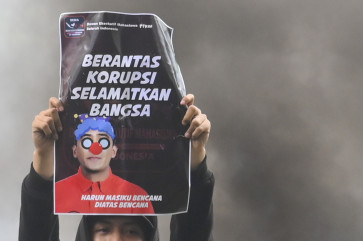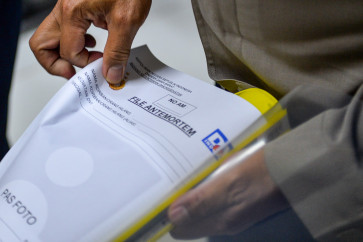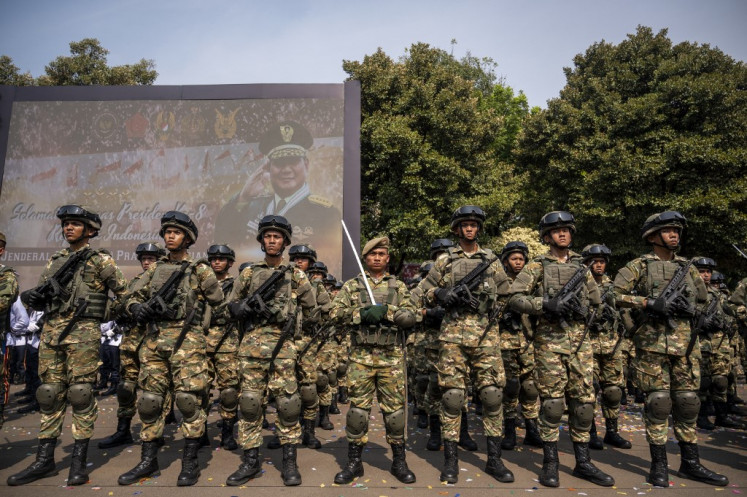Tamil ritual of body piercing in Deli Serdang
Indian ritual: Priests perform the piercing ritual on one of the participants
Change text size
Gift Premium Articles
to Anyone

Indian ritual: Priests perform the piercing ritual on one of the participants.
Murti's face looked very tense, his clenched fists showing white knuckles as his cheeks were about to be pierced with a long iron rod.
However, the 19-year-old youth expressed no pain as the trident-shaped metal spike was driven through both sides of his face by a priest in the ritual of Maha Puja Panguni Uthiram in Sei Semayam, Deli Serdang regency, North Sumatra on March 22.
No blood was shed from Murti's penetrated cheeks. The same was true when the priest stuck dozens of fishhooks into his body following the cheek perforation, with no apparent injuries or blood.
Murti said he was participating in the Panguni Uthiram ritual for the first time. His participation in the Hindu festival was meant to fulfill a nazar (vow) he had made.
'My vow was that after finishing vocational high school, I would take part in the Panguni Uthiram. Today I'm fulfilling that vow,' Murti told The Jakarta Post moments before the ritual was held at Shri Maha Murugan Temple in Sei Semayam.
Hundreds of members of the ethnic Indian Tamil group were involved in the religious celebration at Shri Maha Murugan.
After dining together, they paraded the image of Lord Murugan on foot to a riverbank 2 kilometers from the temple for the body-piercing ritual. Among the Tamil youths enduring the perforation were Murti and another boy Murgen.
Murti said he was taking part in the ritual with the consent of his parents. Although he admitted his apprehension about the body piercing, he had to keep his vow, otherwise he would be even more anxious over the consequences of an unfulfilled pledge.
'Nazar is like a debt, which must be settled, otherwise it will impose a burden on my life,' added Murti, hoping that by fulfilling his school-completion vow he could secure a suitable job.
Like Murti, 16-year-old Murgen, a junior high school graduate, had a strong reason for his vow. He had suffered from hematuria for five days and had promised to take part in the Panguni Uthiram after recovery.
'This is my third ritual. Since then I've had no more hematuria complaints,' said Murgen, who claimed he had no fear of undergoing the perforation having grown accustomed to it.

He revealed that before the ritual he had been fasting for 17 days and sleeping at the temple. During the period, his right hand had been tied with a kanggeno, or turmeric rhizome bracelet, to ward off evil influences.
'We were allowed to eat rice and vegetables and also drink, but no fish or blood-containing meat was consumed while fasting,' said Murgen, referring to the requirements applied to all ritual participants.
A Tamil community figure in Deli Serdang, Mansur, who is a Muslim, pointed out that the Panguni Uthiram tradition was not only limited to Hindus but was also appropriate for other believers.
Mansur said the ritual had originated in India and developed by citizens of Tamil descent in Indonesia. According to him, it has existed in Indonesia since 1880, when the Shri Thendayudabani Temple was built by what was known as the 'Cettiaya' community from India in Lubuk Pakam, Deli Serdang.
However, Mansur said, this celebration came to a halt in the New Order era and was revived in 1999. Today the ritual is annually organized at several Tamil temples in North Sumatra.
'Panguni Uthiram is commemorated to mark the glory of Lord Murugan,' said Mansur, describing the ritual also as a means of safeguarding men against all kinds of evil and helping youths, mostly involved in the activity, avoid drug abuse and gambling.


' photos by JP/Apriadi Gunawan









